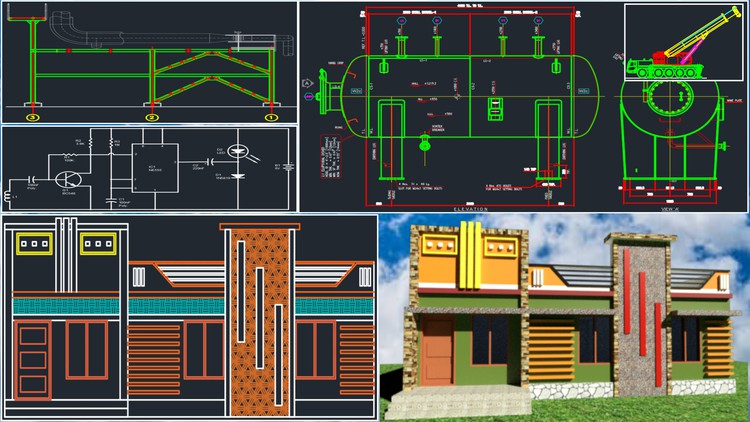Mastering the Foundations: A Comprehensive Guide to AutoCAD Essentials Course for Complete Beginners

Introduction:
AutoCAD, a renowned computer-aided design (CAD) software, is an indispensable tool in the world of design and engineering. If you are a complete beginner eager to embark on a journey of learning AutoCAD, this comprehensive guide is tailored just for you. We will delve into the essential concepts and skills covered in an AutoCAD Essentials course, equipping you with the knowledge to navigate the software confidently and efficiently.
Section 1: Understanding AutoCAD and Its Importance
Subsection 1.1: Introduction to AutoCAD
Get acquainted with AutoCAD and understand its significance in various industries, including architecture, engineering, and manufacturing. Learn about the software’s capabilities and its role in creating precise and detailed drawings.
Subsection 1.2: Applications of AutoCAD
Explore the diverse applications of AutoCAD in real-world scenarios. From 2D drafting to 3D modeling, AutoCAD serves as a versatile tool for professionals across different disciplines.
Section 2: Navigating the AutoCAD Interface
Subsection 2.1: Interface Overview
Familiarize yourself with the AutoCAD interface, including the ribbon, command line, toolbars, and workspace. Understand how these elements contribute to a user-friendly and efficient working environment.
Subsection 2.2: Navigation and View Controls
Master the navigation tools in AutoCAD, including zoom, pan, and orbit. Learn how to control views and navigate through drawings seamlessly, ensuring precision in your design process.
Section 3: Creating and Editing Basic Shapes
Subsection 3.1: Drawing Basics
Delve into the fundamental drawing tools of AutoCAD, such as lines, circles, arcs, and rectangles. Practice creating basic shapes and understand the principles of accuracy and measurement.
Subsection 3.2: Editing Commands
Explore essential editing commands to modify and refine your drawings. From moving and copying objects to rotating and scaling, grasp the techniques for precise manipulation of elements.
Section 4: Mastering Object Properties
Subsection 4.1: Understanding Object Properties
Learn about the properties of objects in AutoCAD, including layers, colors, and linetypes. Gain insights into how these properties impact the visual representation of your drawings.
Subsection 4.2: Layers and Their Importance
Dive into the concept of layers in AutoCAD and discover how they contribute to organizing and managing drawing elements. Explore layer properties and their impact on the overall design.
Section 5: An In-Depth Look at Annotation
Subsection 5.1: Text and Multileaders
Explore the annotation tools in AutoCAD, including text and multileaders. Learn how to add annotations to your drawings, providing essential information and context.
Subsection 5.2: Dimensioning
Master the art of dimensioning in AutoCAD. Understand the various dimensioning tools and techniques for accurately conveying the size and scale of objects within your drawings.
Section 6: Advanced Drawing Techniques
Subsection 6.1: Advanced Object Creation
Move beyond basic shapes and explore advanced object creation techniques. Learn to use tools such as polylines, splines, and hatching to enhance the complexity and richness of your drawings.
Subsection 6.2: Blocks and External References (Xrefs)
Understand the concept of blocks and external references (Xrefs) in AutoCAD. Explore how these features streamline the drawing process and facilitate the reuse of design elements.
Section 7: Introduction to 3D Modeling
Subsection 7.1: 3D Basics
Transition into the realm of 3D modeling in AutoCAD. Gain a foundational understanding of 3D space, coordinates, and the extrusion of 2D shapes into three-dimensional objects.
Subsection 7.2: Creating 3D Objects
Explore the tools for creating 3D objects in AutoCAD. From extruding and revolving to lofting, understand the techniques for bringing depth and dimensionality to your designs.
Section 8: Rendering and Visualization
Subsection 8.1: Materials and Textures
Enhance your 3D models with materials and textures. Learn how to apply realistic surface finishes to objects, creating a visually appealing and immersive experience.
Subsection 8.2: Lighting and Camera Views
Master the principles of lighting and camera views in AutoCAD. Understand how these elements contribute to the rendering process, creating lifelike representations of your 3D models.
Section 9: Collaboration and Output
Subsection 9.1: Sharing and Collaboration
Explore methods for sharing and collaborating on AutoCAD projects. Learn about file formats, project sharing, and best practices for seamless collaboration with team members.
Subsection 9.2: Printing and Exporting
Understand the various options for printing and exporting your AutoCAD drawings. Explore settings for layout creation, paper space, and exporting to different file formats.
Section 10: Troubleshooting and Tips
Subsection 10.1: Common Issues and Solutions
Address common challenges that beginners may encounter in AutoCAD. From unexpected commands to drawing errors, learn how to troubleshoot and navigate these issues effectively.
Subsection 10.2: Keyboard Shortcuts and Efficiency Tips
Boost your productivity with essential keyboard shortcuts and efficiency tips in AutoCAD. Discover time-saving techniques that streamline your workflow and make you a more proficient user.
Section 11: Project-Based Learning
Subsection 11.1: Applying Skills in Real Projects
Capitalize on your newfound knowledge by engaging in project-based learning. Undertake practical exercises and real-world projects to reinforce your skills and build a portfolio of work.
Subsection 11.2: Continuous Learning and Resources
Embrace the journey of continuous learning in AutoCAD. Explore additional resources, online communities, and advanced courses to further expand your expertise and stay updated with the latest developments.
Conclusion:
Congratulations! You have completed the AutoCAD Essentials course for complete beginners. Armed with foundational knowledge and practical skills, you are now equipped to navigate the world of AutoCAD with confidence. Whether you aspire to pursue a career in design, engineering, or architecture, the skills acquired in this course lay the groundwork for your success. May your AutoCAD journey be filled with creativity, precision, and the joy of bringing your design visions to life. Happy drafting!




